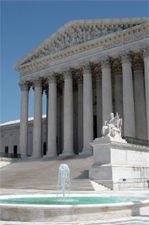Posts Tagged ‘supreme court’
Supreme Court “original jurisdiction” Part II
We did a post recently explaining that even though the Constitution gives the Supreme Court original jurisdiction of controversies between a state and the United States (such as Florida’s suit against Obamacare), that jurisdiction is not “exclusive”, and thus Florida did not have to file its suit first in the Supreme Court. As at least…
Read MoreThe Supreme Court’s “original jurisdiction”
A caller to today’s show read from Article 3, Section 2 of the United States Constitution and, maintained that Judge Vinson’s ruling on Obamacare was unconstitutional because only the Supreme Court could hear the case. So, at the risk of putting everyone to sleep, let me explain the Supreme Court’s “original jurisdiction“. Pursuant to Title 28,…
Read MoreObama administration argues in court: Individual health care mandate is a tax
Yup, that’s right. After spending months ensuring the American people the health care individual mandate is certainly not a tax, the Obama administration’s Department of Justice has gone to court in defense of their mandate, arguing the mandate is a tax.
Read MoreKagen-sure in some cases you can ban books
I am posting this one because it drove a bit of the conversation I had yesterday with Kathryn Jean Lopez from National Review. While arguing Citizens United as Solicitor General, Kagen tried to defend McCain Feingold and it’s limitations on the corporate purchase of political advertising within 30 days of an election. She did not…
Read MoreStates must comply with the Second Amendment
Today, in a very close decision, the Supreme Court ruled in McDonald v. Chicago that no state can pass a law that would violate a citizen’s right to bear arms under the Second Amendment of the United States Constitution. Before going further, though, it is important to understand what the decision does, and what the decision does not…
Read MoreJuan Williams: Obama has declared war on Supreme Court
Well, in particular, Chief Justice John Roberts. Of course this should not come as a surprise to anyone. He declares war on anyone that dares disagree with him.
Read MoreHow will firearm legislation be rewritten? SCOTUS incorporates 2nd Amendment
No time for analysis, but McDonald v. Chicago case has been resolved at the Supreme Court. In a 5 to 4 decision (expected), SCOTUS has ruled the 2nd Amendment is incorporated.
Read MoreFreedom of association and the Supreme Court
Yesterday, the United States Supreme Court heard oral arguments in a case that will attempt to resolve an apparent conflict between the issue of “diversity” and the First Amendment right of “freedom of association”. To me, at least, the facts are fascinating.
Read MoreJustice Stevens retires – decision partially political, tied to mid-term elections
US Supreme Court Justice John Paul Stevens may be retiring for many reasons, but in his resignation letter, he implies the the 2010 mid-term elections were a factor.
Read MoreOh my – Rumors about Chief Justice Roberts resignation begin (Rumors false)
Retracted by RadarOnline. Original below the fold.
Read More





